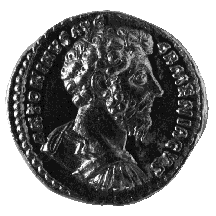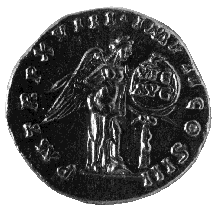



(102) Marcus Aurelius - AV aureus, A.D. 164, 7.13 g. (inv. 91.179).
Obverse: Cuirassed bust of Marcus Aurelius r.; ANTONINVS
AVG(VSTVS) ARMENIACVS: Antoninus Augustus, restorer of Armenia.
Reverse: Victoria r. facing shield inscribed VIC(TORIA)
AVG(VSTI): Victory of the Augustus; P(ONTIFEX) M(AXIMVS) TR(IBVNICIA) P(OTESTATE)
XVIII IMP(ERATOR) II CO(N)S(VL) III: Pontifex maximus, with tribunician
power for the eighteenth time, imperator for the second time, consul
for the third time.
Provenance: Abner Kreisberg, 1970.
Bibliography: H. Mattingly and E.A. Sydenham, The Roman
Imperial Coinage III: Antoninus Pius to Commodus (London 1930) 88; C.
Foss, Roman Historical Coins (London 1990) 136, no. 21.
Marcus Aurelius became emperor upon Antoninus Pius' death on March 7, A.D.
161 and arranged for Lucius Verus to be co-regent with him; this was the
first occurrence of full collegiality in the principate. Although today
Marcus Aurelius is best known as the quintessential Stoic philosopher-ruler,
the greater part of his effort was spent in military affairs. The title
Armeniacus in the legend is connected with the recovery of Armenia from
the Parthians in A.D. 163-164, which the coin celebrates. The reverse is
a type frequently used for a victory; here the shield states specifically
that the emperor is responsible for the victory (Victoria Augusti).
The portrait of Aurelius on the obverse belongs to the third of his portrait
types, of which the most widely known instance is the equestrian statue
that originally stood in front of the Lateran Palace (and that Michelangelo
placed in the center of the Campidoglio). A mature look and long beard with
divided parallel locks characterize portraits belonging to this type; one
cannot escape noticing on these coins the additional emphasis on Aurelius'
already prominent nose. Portraits of Aurelius tend to be works with considerable
psychological depth.
M.D.P.



All contents copyright (c) 1996.
Lawrence University
All rights reserved.